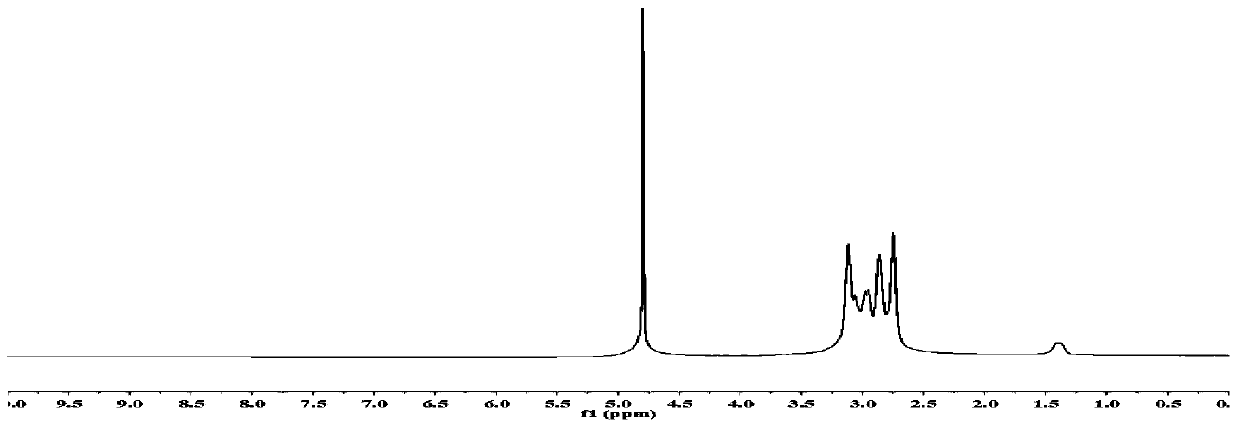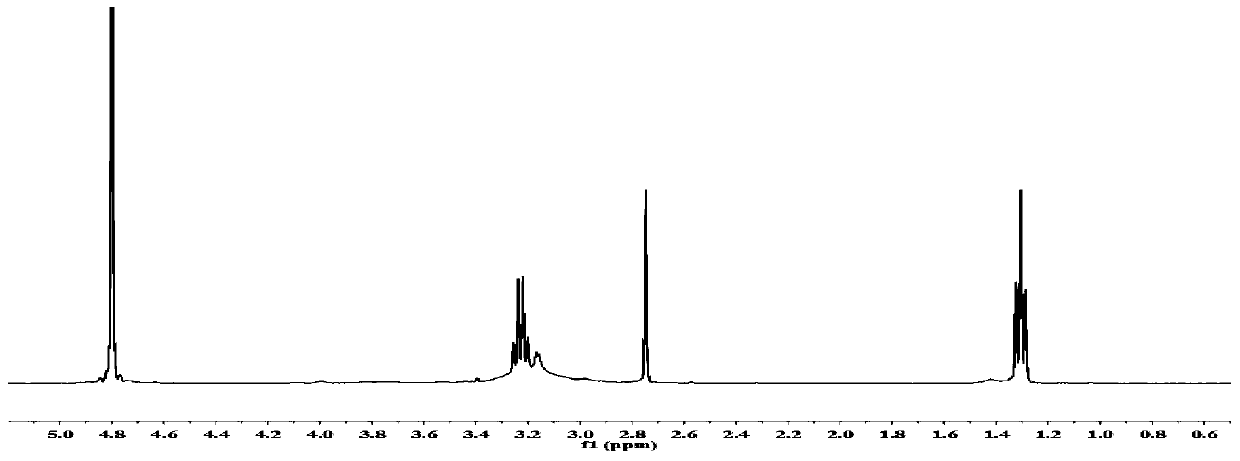Reduction-sensitive polyethyleneimine derivative, its preparation method and application
A polyethylenimine, sensitive technology, applied in the field of biomedical materials, to achieve the effect of improving stability, improving hydrophilic-lipophilic balance, and increasing cell uptake
- Summary
- Abstract
- Description
- Claims
- Application Information
AI Technical Summary
Problems solved by technology
Method used
Image
Examples
preparation example 1
[0047] Preparation Example 1: Preparation of linear PEI with a molecular weight of 2200 (lPEI2200)
[0048] At present, there is no commercially available linear lPEI2200, so we use poly(2-ethyl-2-oxazoline) PEOZ with a molecular weight of 5000 as a precursor, and remove its propionyl group by acid hydrolysis to obtain lPEI2200 with a molecular weight of 2200 , the preparation method is as follows: Weigh about 3 g of poly(2‐ethyl‐2‐oxazoline) PEOZ with a molecular weight of 5000 and place it in a 250 ml round bottom flask, add 120 ml of 24% (wt / vol) hydrochloric acid solution, and heat at 110 °C The oil bath was refluxed for 96 hours, and then the reaction was stopped. After the reaction system was cooled to room temperature, the reaction system was filtered under reduced pressure on a Buchner funnel to obtain a white filter cake, which was air-dried at room temperature to obtain lPEI2200.
preparation example 2
[0049] Preparation Example 2: Preparation of linear PEI with a molecular weight of 22000 (lPEI22000)
[0050] We used poly(2-ethyl-2-oxazoline) PEOZ with a molecular weight of 50,000 as a precursor, and removed its propionyl group by acid hydrolysis to obtain lPEI22000 with a molecular weight of 22,000. The preparation method was as follows: About 3g of poly(2‐ethyl‐2‐oxazoline) PEOZ was placed in a 250ml round bottom flask, 120ml of 24% (wt / vol) hydrochloric acid solution was added, and the oil bath was refluxed at 110°C for 96h, then the reaction was terminated, and the reaction The system was cooled to room temperature, and the reaction system was filtered with Buchner funnel under reduced pressure to obtain a white filter cake, which was air-dried at room temperature to obtain lPEI22000.
preparation example 3
[0051] Preparation Example 3: Low molecular weight polyethyleneimine grafted with aliphatic hydrocarbon group (bPEI1800-C 12 -12.5) Preparation of
[0052] (1) Weigh 1 g of branched polyethyleneimine (bPEI1800) with a molecular weight of 1800, dissolve it in 100 ml of a mixed solvent of dichloromethane and methanol (the volume ratio of the two is 95:5), stir and dissolve at 30 °C ;
[0053] (2) Weigh 0.7245g of 1-bromododecane and dissolve it in 50ml of a mixed solvent of dichloromethane and methanol (95:5 by volume), and add it dropwise to the above-mentioned polyethylene glycol at a rate of 10ml / h. In the amine solution, at 40°C, in the dark for 24 hours;
[0054] (3) The obtained mixed solution was spin-dried by rotary evaporation to obtain a light yellow semi-solid paste. The semi-solid paste was suspended in 6ml of distilled water, and then the dialysis bag with a molecular weight cut-off of 1000 was first used in 40% Dialyzed in ethanol solution for 6 times, and then ...
PUM
 Login to View More
Login to View More Abstract
Description
Claims
Application Information
 Login to View More
Login to View More - R&D
- Intellectual Property
- Life Sciences
- Materials
- Tech Scout
- Unparalleled Data Quality
- Higher Quality Content
- 60% Fewer Hallucinations
Browse by: Latest US Patents, China's latest patents, Technical Efficacy Thesaurus, Application Domain, Technology Topic, Popular Technical Reports.
© 2025 PatSnap. All rights reserved.Legal|Privacy policy|Modern Slavery Act Transparency Statement|Sitemap|About US| Contact US: help@patsnap.com



